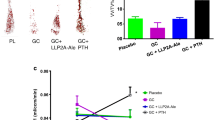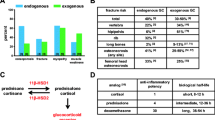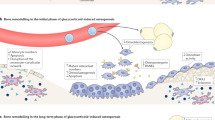Abstract
Glucocorticoids induce rapid bone loss and increase the risk for osteoporotic fractures. The mechanisms include a phase of increased bone resorption, probably a result of the increased expression of receptor activator of nuclear factor-κ-B ligand and colony stimulating factor-1, followed-up by a decrease in bone formation. This effect is central to the actions of glucocorticoids in bone and it is secondary to the loss of bone forming cells, caused by an inhibition of cell differentiation and an increase in the apoptosis of mature osteoblasts and osteocytes. Glucocorticoids also inhibit the function of mature osteoblasts and suppress the synthesis of insulin-like growth factor-I, an agent that enhances bone formation. Glucocorticoids alter the growth hormone/insulin-like growth factor axis in cartilage and, as a consequence, suppress linear growth.
Similar content being viewed by others
References and Recommended Reading
Saag K: Glucocorticoid-induced osteoporosis. Endocrinol Metab Clin North Am 2003, 32:135157. An excellent clinical review on the subject of GIO.
Canalis E, Bilezikian JP, Angeli A, et al.: Perspectives on glucocorticoid induced osteoporosis. Bone 2004, 34:593598. An excellent review on the subject of GIO.
Hattersley AT, Meeran K, Burrin J, et al.: The effect of long- and short-term corticosteroids on plasma calcitonin and parathyroid hormone levels. Calcif Tissue Int 1994, 54:198202.
Rubin MR, Bilezikian JP: The role of parathyroid hormone in the pathogenesis of glucocorticoid-induced osteoporosis: a re-examination of the evidence. J Clin Endocrinol Metab 2002, 87:40334041.
Paz-Pacheco E, Fuleihan GE, Leboff MS: Intact parathyroid hormone levels are not elevated in glucocorticoid-treated subjects. J Bone Miner Res 1995, 10:17131718.
Reid IR, Evans MC, Stapleton J: Lateral spine densitometry is a more sensitive indicator of glucocorticoid-induced bone loss. J Bone Miner Res 1992, 7:12211225.
Suda T, Takahashi N, Udagawa N, et al.: Modulation of osteoclast differentiation and function by the new members of the tumor necrosis factor receptor and ligand families. Endocr Rev 1999, 20:345357.
Hofbauer LC, Gori F, Riggs BL, et al.: Stimulation of osteoprotegerin ligand and inhibition of osteoprotegerin production by glucocorticoids in human osteoblastic lineage cells: potential paracrine mechanisms of glucocorticoid-induced osteoporosis. Endocrinology 1999, 140:43824389.
Rubin J, Biksobing DM, Jadhav L, et al.: Dexamethasone promotes expression of membrane-bound macrophage colonystimulating factor in murine osteoblast-like cells. Endocrinology 1998, 139:10061012.
Weinstein RS, Chen JR, Powers CC, et al.: Promotion of osteoclast survival and antagonism of bisphosphonate-induced osteoclast apoptosis by glucocorticoids. J Clin Invest 2002, 109:10411048.
Dempster DW, Moonga BS, Stein LS, et al.: Glucocorticoids inhibit bone resorption by isolated rat osteoclasts by enhancing apoptosis. J Endocrinol 1997, 154:397406.
Carbonare LD, Arlot ME, Chavassieux PM, et al.: Comparison of trabecular bone microarchitecture and remodeling in glucocorticoid- induced and postmenopausal osteoporosis. J Bone Miner Res 2001, 16:97103.
Pereira RMR, Delany AM, Canalis E: Cortisol inhibits the differentiation and apoptosis of osteoblasts in culture. Bone 2001, 28:484490.
Weinstein RS, Jilka RL, Parfitt AM, et al.: Inhibition of osteoblastogenesis and promotion of apoptosis of osteoblasts and osteocytes by glucocorticoids. J Clin Invest 1998, 102:274282.
Bellows CG, Aubin JE, Heersche JNM: Physiological concentrations of glucocorticoids stimulate formation of bone nodules from isolated rat calvaria cells in vitro. Endocrinology 1987, 212:19851992.
Pereira RC, Delany AM, Canalis E: Effects of cortisol and bone morphogenetic protein-2 on stromal cell differentiation: correlation with CCAAT-enhancer binding protein expression. Bone 2002, 30:685691.
Wu Z, Bucher NLR, Farmer SR: Induction of peroxisome proliferator- activated receptor g during the conversion of 3T3 fibroblasts into adipocytes is mediated by C/EBPb, and glucocorticoids. Mol Cell Biol 1996, 16:41284136.
Pereira RC, Delany AM, Canalis E: CCAAT/Enhancer binding protein homologous protein (DDIT3) induces osteoblastic cell differentiation. Endocrinology 2004, 145:19521960.
Smas CM, Chen L, Zhao L, et al.: Transcriptional repression of pref-1 by glucocorticoids promotes 3T3-L1 adipocyte differentiation. J Biol Chem 1999, 274:1263212641.
Moon YS, Smas CM, Lee K, et al.: Mice lacking paternally expressed Pref-1/Dlk1 display growth retardation and accelerated adiposity. Mol Cell Biol 2002, 22:55855592.
Canalis E, Economides AE, Gazzerro E: Bone morphogenetic proteins, their antagonists and the skeleton. Endocr Rev 2003, 24:218235. An excellent review on bone cell biology.
Westendorf JJ, Kahler RA, Schroeder TM: Wnt signaling in osteoblasts and bone diseases. Gene 2004, 341:1939. An excellent clinical review on bone cell biology.
Ohnaka K, Taniguchi H, Kawate H, et al.: Glucocorticoid enhances the expression of dickkopf-1 in human osteoblasts: novel mechanism of glucocorticoid-induced osteoporosis. Biochem Biophys Res Comm 2004, 318:259264.
Weinmaster G: Review: the ins and outs of notch signaling. Mol Cell Neurosci 1997, 9:91102.
Sciaudone M, Gazzerro E, Priest L, et al.: Notch 1 impairs osteoblastic cell differentiation. Endocrinology 2003, 144:56315639. New signals involving mechanisms of glucocorticoid action in bone.
Crowe R, Zikherman J, Niswander L: Delta-1 negatively regulates the transition from prehypertrophic to hypertrophic chondrocytes during cartilage formation. Development 1999, 126:987998.
DeStrooper B, Annaert W: Where Notch and Wnt signaling meet: the presenilin hub. J Cell Biol 2001, 152:F17F20.
Axelrod JD, Matsuno K, Artavanis-Tsakonas S, et al.: Interaction between Wingless and Notch signaling pathways mediated by Disheveled. Science 1996, 271:18261832.
Foltz DR, Santiago MC, Berechid BE, et al.: Glycogen synthase kinase-3b modulates Notch signaling and stability. Curr Biol 2002, 12:10061011.
Pereira RMR, Delany AM, Durant D, et al.: Cortisol regulates the expression of Notch in osteoblasts. J Cell Biochem 2002, 85:252258.
Delany AM, Durant D, Canalis E: Glucocorticoid suppression of IGF I transcription in osteoblasts. Mol Endocrinol 2001, 15:17811789.
Okazaki R, Briggs BL, Conover CA: Glucocorticoid regulation of insulin-like growth factor-binding protein expression in normal human osteoblast-like cells. Endocrinology 1994, 134:126132.
Devlin RD, Du Z, Buccilli V, et al.: Transgenic mice overexpressing insulin-like growth factor binding protein-5 display transiently decreased osteoblastic function and osteopenia. Endocrinology 2002, 143:39553962.
Delany A, Gabbitas B, Canalis E: Cortisol down-regulates osteoblast a1 (I) procollagen mRNA by transcriptional and post-transcriptional mechanisms. J Cell Biochem 1995, 57:488494.
Rydziel S, Delany AM, Canalis E: AU-Rich elements in the collagenase 3 mRNA mediate stabilization of the transcript by cortisol in osteoblasts. J Biol Chem 2004, 279:53975404.
Hock JM, Centrella M, Canalis E: Insulin-like growth factor I (IGF-I) has independent effects on bone matrix formation and cell replication. Endocrinology 1988, 122:2227.
Canalis E: Inhibitory actions of glucocorticoids on skeletal growth. Is local insulin-like growth factor I to blame? Endocrinology 1998, 139:30413042.
Reid IR, Gluckman PD, Ibbertson HK: Insulin-like growth factor I and bone turnover in glucocorticoid-treated and control subjects. Clin Endocrinol (Oxf) 1989, 30:347353.
Bachrach LK: Bare-bones fact children are not small adults. N Engl J Med 2004, 351:924926.
Singleton JR, Baker BL, Thorburn A: Dexamethasone inhibits insulin-like growth factor signaling and potentiates myoblast apoptosis. Endocrinology 2000, 141:29452950.
Dehoux M, Van Beneden R, Pasko N, et al.: Role of the insulinlike growth factor I decline in the induction of atrogin-1/ MAFbx during fasting and diabetes. Endocrinology 2004, 145:48064812.
Tomlinson JW, Walker EA, Bujalski IJ, et al.: 11b-hydroxysteroid dehydrogenase type 1: a tissue-specific regulator of glucocorticoid response. Endocr Rev 2004, 25:831866.
Author information
Authors and Affiliations
Rights and permissions
About this article
Cite this article
Canalis, E. Mechanisms of glucocorticoid action in bone. Curr Osteoporos Rep 3, 98–102 (2005). https://doi.org/10.1007/s11914-005-0017-7
Issue Date:
DOI: https://doi.org/10.1007/s11914-005-0017-7




